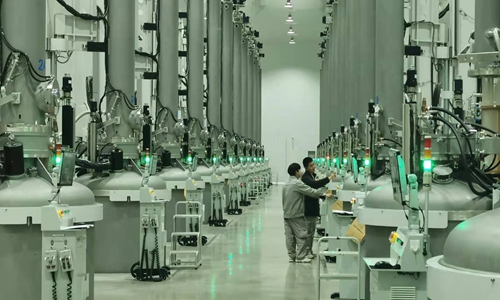
A production workshop in Qujing, the PV industrial hub in Southwest China's Yunnan Province. Photo: Yin Yeping/GT
Prices of silicon materials are falling from historic highs amid a government clampdown on high bulk commodity prices, as a reasonable price level will accelerate the downstream expansion of solar power stations, helping China reach its carbon reduction targets.
Silicon prices peaked in October and have remained elevated ever since. But the government efforts, combined with domestic companies' production expansion and technology advances, stabilized prices in the global market, where China has the biggest share in output and consumption.
This week, the prices of silicon materials dropped further, falling about 5 percent from the previous month.
As of Wednesday, the main silicon price was about 249 yuan ($39) per kilogram, down 8 percent from the peak in October.
The trend was driven by multiple factors. Beyond seasonal shrinking demand ahead of the Chinese lunar New Year holiday, companies increased output and drew down their inventories.
Starting in late November, industry conglomerate LONGi began to cut prices, and some other industry players also announced price cuts or production hikes.
Yunnan Energy Investment Silicon Technology Development Co, a leading silicon producer, is planning to open the second phase of its facility in Qujing, the booming silicon hub in Southwest China's Yunnan Province. The first phase is operating with annual output of 200,000 tons.
"Our current capacity utilization is only 50-60 percent, and capacity will gradually increase," Zhang Bing, general manager of the company, told the Global Times.
An employee at a large wafer producer told the Global Times on condition of anonymity on Wednesday that the company expanded capacity by up to 10 percent in October.
Further expansion is in progress this month due to rising demand.
The wide adoption of cutting-edge production technologies is driving down prices. For example, wafers that are used for solar panels are becoming slimmer, which saves material costs.
Keeping prices at a reasonable level is in the best interests of participants at all stages of the industry chain. High silicon prices at the upstream meant severe profit pressure on midstream producers, with the end result of lower downstream demand, industry insiders said.
The total installed capacity of new PV projects in China was only 34.8 gigawatts in the first 11 months of this year, much less than the expected 60GW, because of high prices, Wang Feng, general manager of business development at Shanghai Huaneng E-Commerce Co, told the Global Times on Wednesday.
Due to the high prices for silicon, investment yields at PV plants fell to about 5 percentage points from 7 points previously, Wang said.
The country's policy of stabilizing prices and guaranteeing the supply of bulk commodities is helping normalize the situation.
The China Securities Regulatory Commission said earlier this month that it would better leverage the active role of the commodity futures market to help ensure supply, stabilize prices, and develop green and low-carbon transitions, according to media reports.
Experts said that the development of futures is of great significance to the production of silicon materials since companies can effectively hedge against spot price fluctuations, and they can also detect price trends earlier.
Global Times

